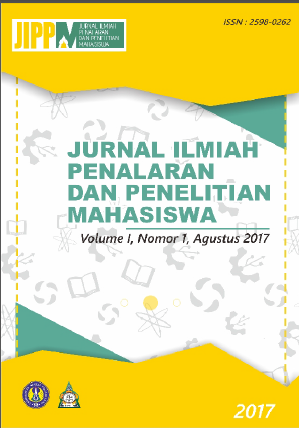TAMAN PRODUKTIF MASYARAKAT DENGAN VERTICAL GARDEN BY AQUAPONIK SYSTEM (VGAS) BERBASIS DISTRIBUSI TERKENDALI DI KAMPUNG CODE YOGYAKARTA
Main Article Content
Abstract
The high population of Code Village causes the area become densely and slum area. It is exacerbated by the low level of family welfare that affecting the fulfillment of family needed. Vertical Garden by Aquaponik System (VGAS) is a solution to realize a clean environment and can provide foodstuffs. Aquaponic technology is a combination of aquaculture and hydroponics technologies to optimize water and space available functions as a maintenance media (Nugroho et al., 2012). Waste produced by fish is used as fertilizer for plants (Wahab et al., 2010). VGAS consists of fish storage, controlled distribution pipes, planting media or vertical garden, and energy sources. The water is distributed to the planting media in civil homes according to the needs of the plants that controlled by controlled distribution system. The method of writing in this scientific paper is descriptive qualitative. In addition, the authors use a variety of appropriate reference problems which called library research. The steps of writing on this paper is formulating the problema, collecting the data, processing the data, analysis and synthesis (discussion), and conclusion. The results obtained from this paper are (1) VGAS design and prototype. (2) The working principle, that is fish maintenance pool, controlled distribution pipeline, planting medium, energy source, and management system. With this system, the environment is expected to be maintained and the space around the house to be productive area.
Article Details
References
Budihartono, Widodo. 2005. Panduan lengkap belajar mikrokontroler perancangan sistem dan aplikasi mikrokontroler. PT.Elex Media Komputindo. Jakarta.
Budioko, Totok. 2005. Belajar dengan mudah dan cepat pemprogaman bahasa C dengan SDCC pada mikrokontroler. Edisi Pertama. Penerbit Gava Media. Yogyakarta.
Fadhil, M., B, D, Argo, dan Y Hendrawan. 2015. „Rancang Bangun Prototype Alar Penyiram Otimatis dengan Sistem Timer RTC DS1307 Berbasis Mikrokontroler Atmega 16 pada Tanaman Aeroponik‟. Jurnal Keteknikan Pertanian Tropis dan Biosistem 3(1): 37-43.
Hadi, S. 2008. Mengenal Mikrokontroler AVR Atmega16. Bandung.
Khairuman, & Amri. 2002. Budidaya Lele Dumbo secara Intensif. Agromedia Pustaka, Jakarta. Nugroho, R., L. Teguh, D. Chilmawati, dan A. Herjuno. 2009. Aplikasi Teknologi Aquaponik pada
Budidaya Ikan Air Tawar untuk Optimalisasi Kapasitas Produksi. Jurnal Saintek Perikanan 8(1): 1-6.
Putra, E.A. 2002. Konsep dan Aplikasi RTC. Graha Ilmu. Jakarta.
Rokhmah, N., C. Soraya, dan Y. Sastro. 2014. Vertiminaponik, Mini Akuaponik untuk Lahan Sempit Lahan di Perkotaan. Buletin Pertanian Perkotaan 4(2): 14-21.
Rompas, P. 2011. Analisis Pembangkit Listrik Tenaga Mikrohidro (PLTMH) pada Daerah Aliran Sungai Ongkak Mongondow di Desa Muntoi Kabupaten Bolaang Mongondow. Jurnal Penelitian Saintek 5(1): 64-75.
Rukmana, R. 1997. Ikan Nila Budidaya dan Prospek Agribisnis. Kanisius. Yogyakarta.
Sastro, Y., I.P. Lestari. C.S. Amatillah, L. Hakim, E.P. Astuti, M. Nur. 2013. Pengkajian Sistem Akuaponik Sayuran Skala Pekarangan di Perkotaan. BPTP Jakarta. 31 halaman.
Sinaga, B.J. 2009. Perancangan Turbin Air Untuk Sistem Pembangkit Listrik Tenaga Mikrohidro (Studi kasus Desa Way Gison Kecamatan Sekincau Kabupaten Lampung Barat). J. Sainsdan Inovasi 16(2): 1-12.
Suyanto. 2006. Budidaya Ikan Lele. Swadaya. Jakarta.
Tacon A. G. J. 1987. The Nutrition and Feeding of Farmed Fish and Shrimp. A Training Manual Food and Aquaculture Organization of United Nation Brazilia. Brazil.
Turker, H. et al. 2003. „Comparative Nile Tilapia and Silver Carp Filtration Rates of Partitinoed Aquaculture system Phytoplankton‟. Aquaculture. 220: 449-457.
Wahab, M. A., Jellali, S., and Jedidi, N., (2010), Ammonium biosorption onto sawdust: FTIR analysis, kinetics and adsorption isotherms modeling, Bioresource Technology, 101(14): 5070-5075.

